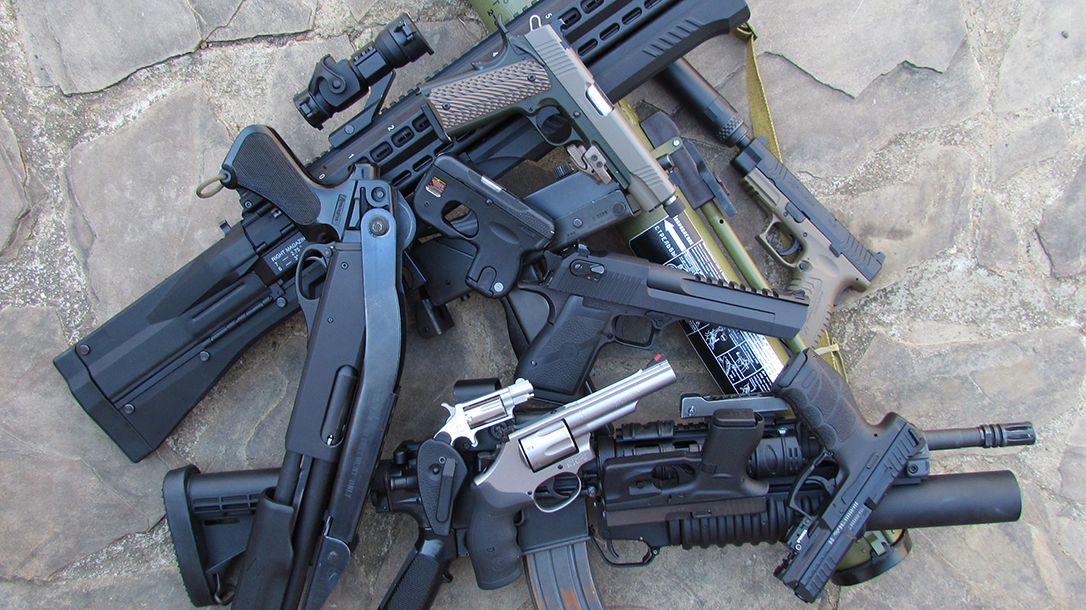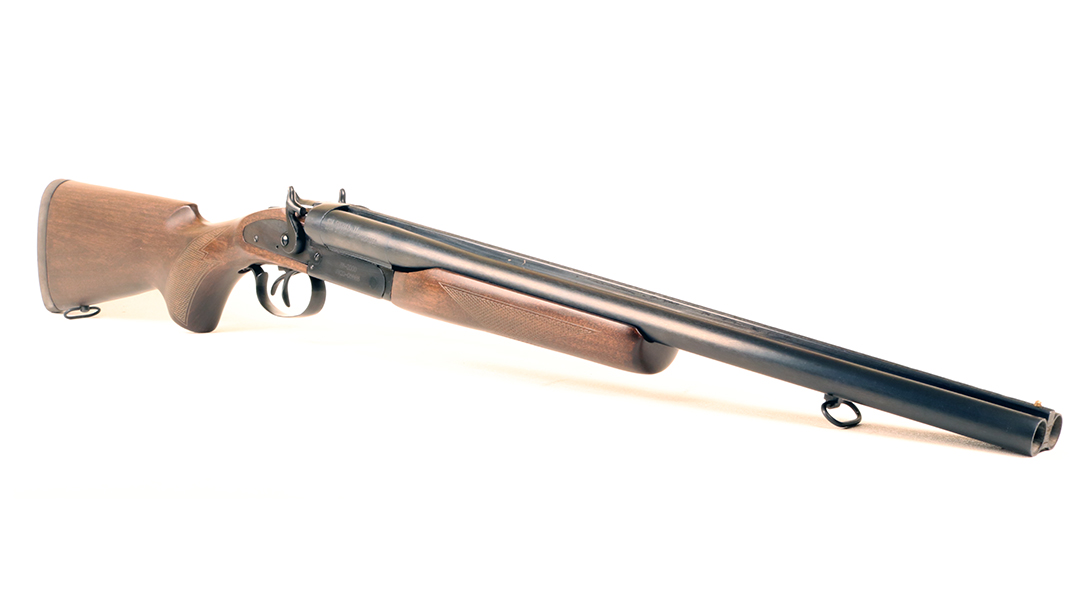What is the ideal home-defense weapon? A river of ink has been spilt chasing that thorny question. Everywhere there are gun owners, there will be arguments about home-defense weapons. The perfect home-defense array would be a platoon of Rangers, a CONEX box filled with Claymore mines and a drone bristling with Hellfire missiles circling silently overhead. However, that’s a bit extreme even by my standards. In the real world, selecting one from numerous home-defense weapons is a decision driven by a variety of factors.
Thinking Clearly About Home-Defense Weapons
It all begins with a sober threat assessment. Do you live in a rural orphanage filled with inquisitive children half an hour from the nearest sheriff’s deputy? Or in a domicile with a few responsible adults next door to the police station? Are you a military veteran with a zillion rounds under your belt or a neophyte just getting into the game? Such details drive the gear.
Advertisement — Continue Reading Below
For starters, you simply must ensure that little fingers cannot get to your defensive guns. If you cannot be certain of that, then you need to opt for a non-lethal solution. PepperBall and Taser make some good ones. If you can manage real steel, then it is time to move on to the next decision.
Smoothbores as Home-Defense Weapons
Once you have determined it is safe to own a firearm, it is time to divine exactly what sort of gun you need. While most folks default to a handgun, a pistol is actually one of the toughest guns to shoot well. Though a handgun is a good choice for many shooters, sometimes something longer might be a better fit.
Pump shotguns have a robust following, and for good reason. Nothing on the market carries more downrange horsepower than a properly stoked 12 gauge. However, a 12-gauge shotgun can be a complicated beast to run in a hurry, and its muzzle blast and recoil are invariably intimidating. If it is miserable to shoot a gun, then that becomes a disincentive to train. A firearm without proficiency is a liability.
Advertisement — Continue Reading Below
No less a firearms visionary than our own former Vice President Joe Biden once opined that the humble double-barreled 12 gauge was the optimal home-defense weapon. Personally, I wouldn’t trust Joe with yarn, much less a live weapon, but his argument does have some merit. Single- and double-barreled scatterguns are easy to run, and a 20- or .410-gauge shotgun does have a friendlier personality than its larger 12-gauge sibling.
If you opt for a shotgun, selecting among autoloaders, pump-action repeaters and break-open designs is half the fun. Imported single- and double-barreled guns are tire-iron reliable and dirt cheap. High-end gas-operated race guns can cost a fortune. That rarefied space in between sells a lot of quality gun magazines.
Rifles & Carbines as Home-Defense Weapons
Black rifles are ubiquitous these days, at least in the free states. If your home state sucks so bad that they don’t trust you with a proper defensive rifle, you should move. Down in the Deep South where I live; however, we take our freedom seriously.
Advertisement — Continue Reading Below
Modern sporting rifles, like AR-15s, enjoy negligible recoil, a prodigious magazine capacity and exquisitely engineered ergonomics. Such a gun is easy to learn and easy to run. Additionally, it seems counterintuitive, but a high-velocity .223 Remington bullet frequently doesn’t penetrate as wantonly through common building materials as might a heavier pistol round.
AR- and AK-platform rifles make up most of the fare these days. However, the AUG, SCAR, M1A, FAL and dozens of others keep the market vigorous. MSRs are civilianized versions of military tools, so they are designed to be efficient and effective. In the hands of a determined homeowner, such a rifle becomes an excellent equalizer.
Advertisement — Continue Reading Below
Of course, the perfect home-defense firearm might actually be a pistol-caliber submachine gun. These are functionally recoilless and easily controllable by just about anybody. However, the prejudices of the uninitiated conspire to keep these splendid tools out of most civilian hands. There are, however, some effective facsimiles available.
Sig Sauer, Zenith, CZ-USA and a few others offer semi-auto, pistol-caliber carbines and pistols. Pistol variants equipped with revolutionary “pistol stabilizing braces” offer most of the submachine gun awesomeness without any of the NFA baggage or exorbitant expense of a fully automatic weapon. Stubby rifle-caliber guns are comparably effective, though the muzzle flash and blast from those short barrels can rock your world in enclosed spaces.
Revolvers as Home-Defense Weapons
Despite the relative challenges of learning to run a handgun well, pistols are the most popular defensive firearms in America. They come in hundreds of shapes, sizes and calibers for every budget and personality. To understand the handgun market in America, one needs to understand some basic morphology.
Advertisement — Continue Reading Below
Revolvers once ruled the roost. Starting with Samuel Colt’s iconic Peacemaker, wheelguns offered that magical combination of reliability, accuracy, portability and power required to dominate the defensive firearm scene. Even today, there remains a place for a proper revolver.
A modern defensive revolver offers the safety of a long double-action trigger pull along with the option of a crisper single-action pull should the situation call for more precision. Though they are a bit slower to load than a comparable autoloader, revolvers manage heavier rounds better and are fairly stupid-proof. Just point the gun in the direction of something you dislike and squeeze.
Autoloaders as Home Defense Weapons
This deep into the Information Age; however, it is the autoloader that fills most folks’ holsters. John Moses Browning designed the vast majority of pistols. However, gun companies make and lose fortunes in the nuances of magazine capacity, caliber, safeties and hues. Whether you have large mitts or small, there is something out there for you.
Advertisement — Continue Reading Below
Defensive handguns also diverge further based upon their mission. If the gun is to hide in your bedside table or in the glove box of your car, then size and bulk don’t mean a great deal. If the gun will ride on your belt underneath a T-shirt throughout a torrid Mississippi summer, size, shape and weight become critical attributes. Once again, the indomitable engine of capitalism feeds the need.
Most companies build mainstream combat pistols and carry guns around polymer frames these days. Everybody makes them, and concerns regarding their durability, reliability and invisibility have been long since put to rest. Your tolerance for weight and bulk drives the caliber and magazine capacity, while barrel length and frame dimensions determine whether or not the gun can be readily concealed. The trigger design and ergonomics are likely the reasons you purchased this periodical in the first place.
A Word On The 1911
John Browning’s inimitable Model 1911 deserves special mention. Despite that the 1911 first drew breath back during the administration of the last American president to sport a proper mustache, William Howard Taft, the 1911 continues to arm gunmen of distinction even today. Today, shooters can find 1911s with frames conjured of polymer, aluminum and good old-fashioned ordnance steel. There are barrel lengths and calibers aplenty, as well as enough ancillary widgets and accessories to sink the Titanic.
Advertisement — Continue Reading Below
The single-action trigger of the 1911 is the standard by which all others are judged, and the gun’s array of safety devices, both manual and otherwise, keep it inert until called upon to become angry. Particularly in its steel-framed guise, the 1911 is a boat anchor to carry concealed, but that hasn’t kept me from toting one halfway around the planet in all fashions and climes. Home defenders wielding a full-size 1911 will never be accused of not packing enough gun.
Ruminations
Selecting a proper first defensive firearm is a huge undertaking. We pack a gun so that if the unthinkable occurs, we will be ready to defend our home and families with deadly force if needed. Of all the many deplorable attributes of the human animal, the fact that we even have to contemplate such wretched horrors speaks to our innate inability as a species to embrace civility. However, despite their undeniably dark mission, firearms really are fun when used properly.
The details demand sober assessment, while the allure of power under control carries a timeless appeal. In the face of this most intimate of decisions, the modern gun market inundates the new gun consumer with myriad choices. While the details can seem overwhelming at first brush, we gun nerds are typically an amiable lot and enthusiastic to help.
Advertisement — Continue Reading Below
Once the trappings grow familiar, the ambience of the local gun emporium or firing range become conducive to splendid recreation and superb fellowship. Competition, training or just swapping lies over a Coke can be a great way to while away a lazy afternoon. This storied culture orbits reliably around the many-splendored facets of humble home-defense weapons.






























